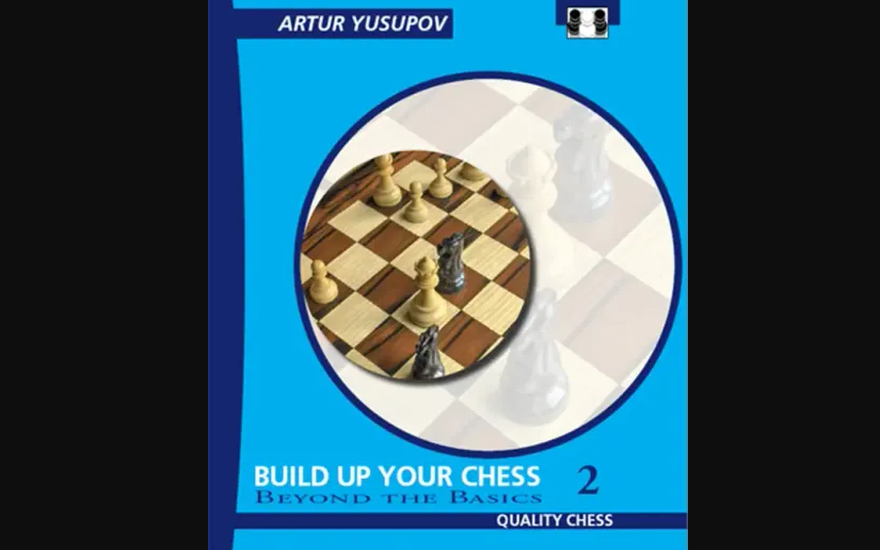
Quality Chess & Artur Yusupov
Build Up Your Chess 2: Beyond The Basics & ChessTempo review
A book and ChessTempo review.This blog post will be a high-level overview of Artur Yusupov's book, <em>Build Up Your Chess 2: Beyond the Basics</em>. The [blue] books had previously never been published in an easy-to-consume format like Chessable, ichess, or any other e-board site.
The books were published on ChessTempo and you can read more about them in the site's blog here. ChessTempo has always been known as a chess exercise website and not much else. A couple of years ago, the site started changing that image by launching a chess "books" feature for authors to publish their materials on ChessTempo. This is not a sponsored review.
I'd like to preface this review by saying that my intention here is to give straightforward feedback and thoughts on the book & site. I peer-reviewed every single diagram & exercise in this book, and have left feedback relevant to the problems in a Google spreadsheet here. This document is relevant for ChessTempo developers as there are numerous ideas they will find useful. The spreadsheet and blog should go a long way toward providing them with useful feedback to improve their site.
You can find a free sample of this book on Quality Chess' website here. In my opinion, it's intended for players between 1650 and 2100 FIDE.
Preface
Diving straight into the book, it begins with a preface by Anand telling the reader how Yusupov's coaching materials affected him and the amateurs who studied under him. It's a solid endorsement of Yusupov's books.
Introduction
This section is the most critical in the book. It outlines how the reader should approach the tests in the book. Each chapter has 3 sections:
1. Overview: This is a text-only page and gives you an idea of what to expect in the chapter.
2. Diagrams: These are examples you can challenge yourself and mull over.
3. Exercises: These are the tests you will be graded on. Each diagram (12 total) is worth a certain amount of points (they vary in difficulty), from which you will be graded. Depending on your score, you may end up with:
- Excellent
- Good
- Pass
- Fail
If you fail a chapter's exercises, Yusupov recommends you go back and re-think about the positions you did poorly on. Of the 25 chapters in the book, I (roughly) got Excellent on 4-5 of the chapters, Good on 15-16 of them, and Pass on the rest.
I don't like that he doesn't give recommendations in case a user barely gets a "Pass" or "Good" score. From the text, I'd assume it's no big deal that I missed some exercises, but I'd appreciate a bit more guidance on his end for players like myself.
Chapters 1 through 24
As mentioned before: these chapters are outlined in the Overview, Diagram, and Exercise sections. These chapters cover a broad range of topics such as dynamics, positional understanding, openings, endgames, and other key parts of chess that are core to improving.
Here's a sample of how it usually goes (examples below are taken from the book).
Overview
Example Diagram (4-3)
There are 7 total diagrams in Chapter 4. I've selected the one below for illustrative purposes.
Example Exercise (4-11)
Likewise, I've picked one of the 12 exercises from the same chapter.
Chapter 25 (Final Test)
The book follows this format with a final test chapter containing exercises only. It's a nice way to wrap up the text's material in totality and makes for a strong finish.
Book Review
So what are my overall thoughts on the book itself? Well, I like the format and structure of the book. It's nice to have a way to measure my success through a point system. I'm able to finish a chapter every 2-3 days and it's easy for me to schedule this book into my daily routine.
I also think the exercises are well-chosen and are taken from years of experience on Yusupov's end. He prioritizes (for the most part) practical and realistic chess positions. I like that each chapter covers a part of chess that happens in my games.
<strong>Overall, I'd give it 9/10</strong>, but the book has some issues worth pointing out. The issues (not too major) with the book are noted below. Congratulations on ChessTempo's staff & beta testers for being able to properly convert it onto the site.
Book issues (screenshots taken in Study Mode)
1. Yusupov loves giving text hints (It spoils the solutions in many cases). I despise this. It takes away the thinking I have to do (example below). Every single exercise in the Final Test chapter contains the chapter an exercise is associated with, thereby signaling to the student what to look for. I know I said the book has a strong finish, but the hints left a sour taste in my mouth.
2. Yusupov's score system can be rather unforgiving sometimes (example below. 1.Bxh5 is far more natural, arguably as good as the text, but he only gives it 1 point. Probably he should give it 2 points. There are a few other examples of him not delegating points fairly.
3. Yusupov's exercises are sometimes flawed (Example below. I'm not obsessed with engine evaluations, but the book can be better in this area).
ChessTempo Review
I've discussed the book itself, but what about the site itself?
To read this book properly, I used the Study mode and didn't bother with any of the other modes.
Once you click <em>Study</em>, you're taken to a reader-like page as shown in the previous screenshots above (Under Book <strong>Issues</strong>).
I used this mode to go through the entire course. I think it has several promising features.
ChessTempo offers many other modes to allow users to review their books through spaced repetition, but fro a book like this, it is not useful. For opening courses, it could be useful though.
Study Mode: Simple to read & Quizzes
I like the initial interface. It's simple and easy to read in the mode. This is arguably the most important thing when reading through a book: Is it easy to get distracted while reading the text on the page?
As a point of comparison, chessable.com's reading UI has suffered from a cramped & visually unappealing layout for over 5 years now. I much prefer reading on ChessTempo, even though I am a Chessable author.
ChessTempo Read mode
Chessable read mode (taken from my King's Indian course): I feel claustrophobic about Chessable's reading panes.
The site also has quizzes that test whether you calculated subvariations properly. This is consistent with what Yusupov says in his Introduction about writing/calculating all relevant subvariations for each Exercise position. Here's what that looks like below.
That being said, I have many thoughts on how to improve the user experience. Bear in mind, ChessTempo books is in beta still. ChessTempo has the foundation of its study mode nailed down excellently. Below are features I view as promising/necessary additions.
Site Suggestions
<strong>1. Add a counter to show subvariation puzzle #</strong>.
Inside the red box (or somewhere similar) below, display "1/6" since this is the first subvariation quiz.
2. Make read-only diagrams (from the spreadsheet) into puzzles, but the user doesn't have to solve them.
Have the user click "Next" after the cutoff (noted by the red and blue lines. Some discussion about where the cutoff is best, should be had)
This is in the spirit of what Yusupov was asking for in the Introduction when he said to think for 5 minutes on all diagram positions, even the "read-only". Right under the cutoff lines, have a "Next" button for the user to click after they are done thinking. The current format encourages users to skip the Read-Only positions.
3. Table of Contents feedback:
- ChessTempo doesn't have the cleanest table of contents (its plain text)
- It doesn't automatically scroll/choose the current page I am on.
- Also, the chapters in the table of contents should be "collapsible". It takes forever for me to scroll through the entire popup.
4. Add a way to leave position comments within the book's study mode
ChessTempo has this functionality for its site's puzzles, but not within Study Mode.
It's a must-add.
5. Add a way to turn off preliminary hints
These are annoying. Please let us remove them.
Edit: Full disclosure, I sent a sample of the spreadsheet to the ChessTempo admin, Richard, before publishing this review. In response to this spreadsheet, he adjusted ChessTempo's study mode text hints so that we can turn off the spoiler text hints. Good addition, Richard.
6. Need to add quizzes from both colors
Sometimes, in the Yusupov exercises, I'll read subvariations/missed opportunities noted in the text by the opponent. However, I did not come across a single subvariation puzzle in the book from the opponent's point of view (If we are White, we should be quizzed to find Black's best continuation from Black's point of view). ChessTempo should add subvariation puzzles, regardless of whether it is from our point of view or our opponents.
The possible example below (quiz for Black to solve):
7. Make URLs clickable
I don't recall any links in the book being clickable. Do books let users point and click on URLs? It's unclear to me.
Edit: ChessTempo does make URLs clickable so this is not an issue.
8. Toggle folding should be a saved setting
Currently, "Toggle variations" is a saved setting. Great.
Please do the same for "Toggle Folding".
9. Make clickables more engaging to read.
Below feels so bland and hard to follow. Maybe add different color schemes or make the moves appear a different color/font than regular text?
Conclusion
I'm sure other people have worthwhile feedback that the site admin will read, so please leave them in the blog's comment section.
I hope this was a helpful read. ChessTempo's base read mode is simple and Yusupov's book is an outstanding read. I'd definitely recommend the book to any player rated between 1650-2100 FIDE and would give it a 9/10 rating.
As noted, with further improvements, the user experience will be close to perfection.
Best,
InfiniteFlash

